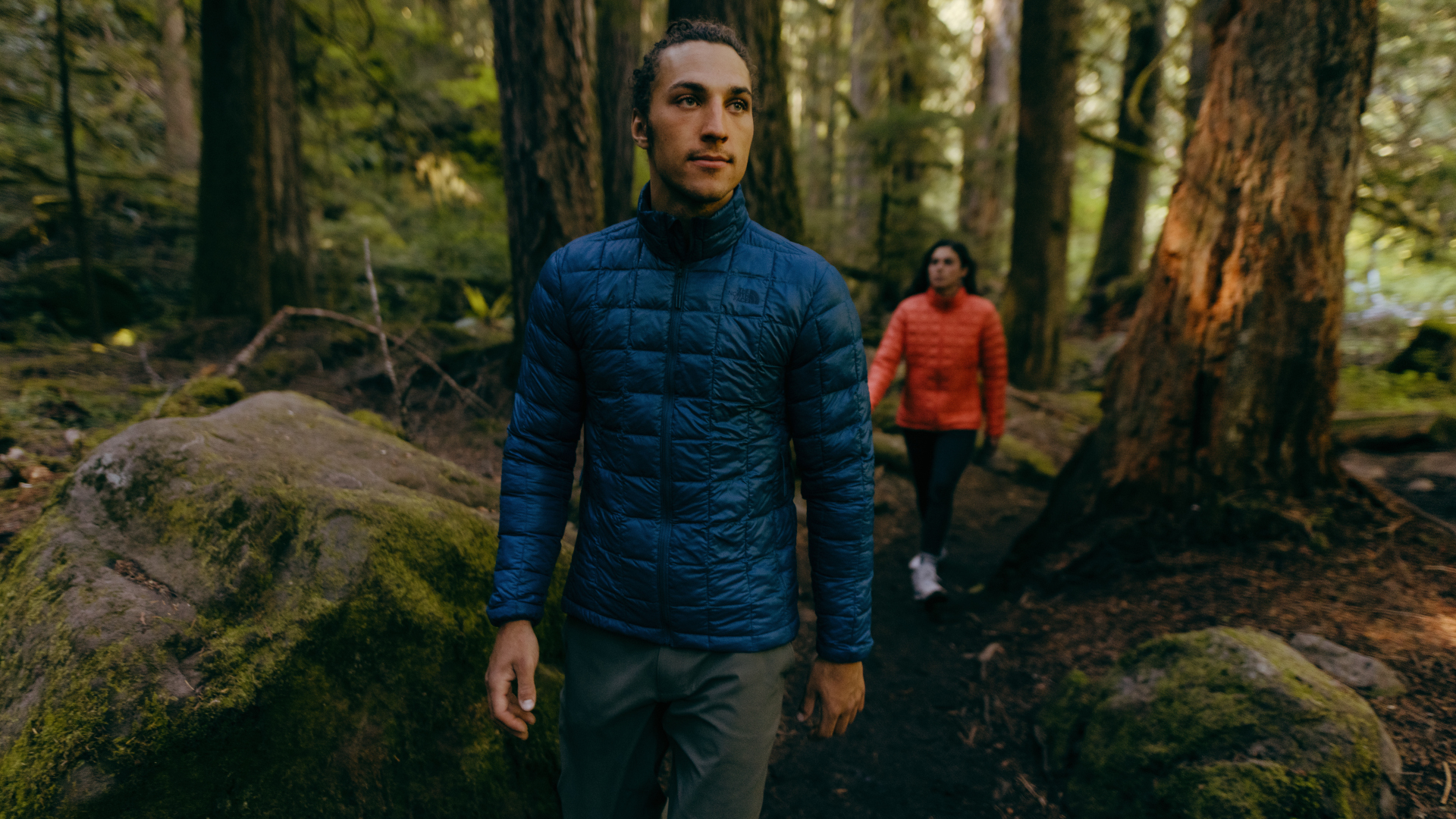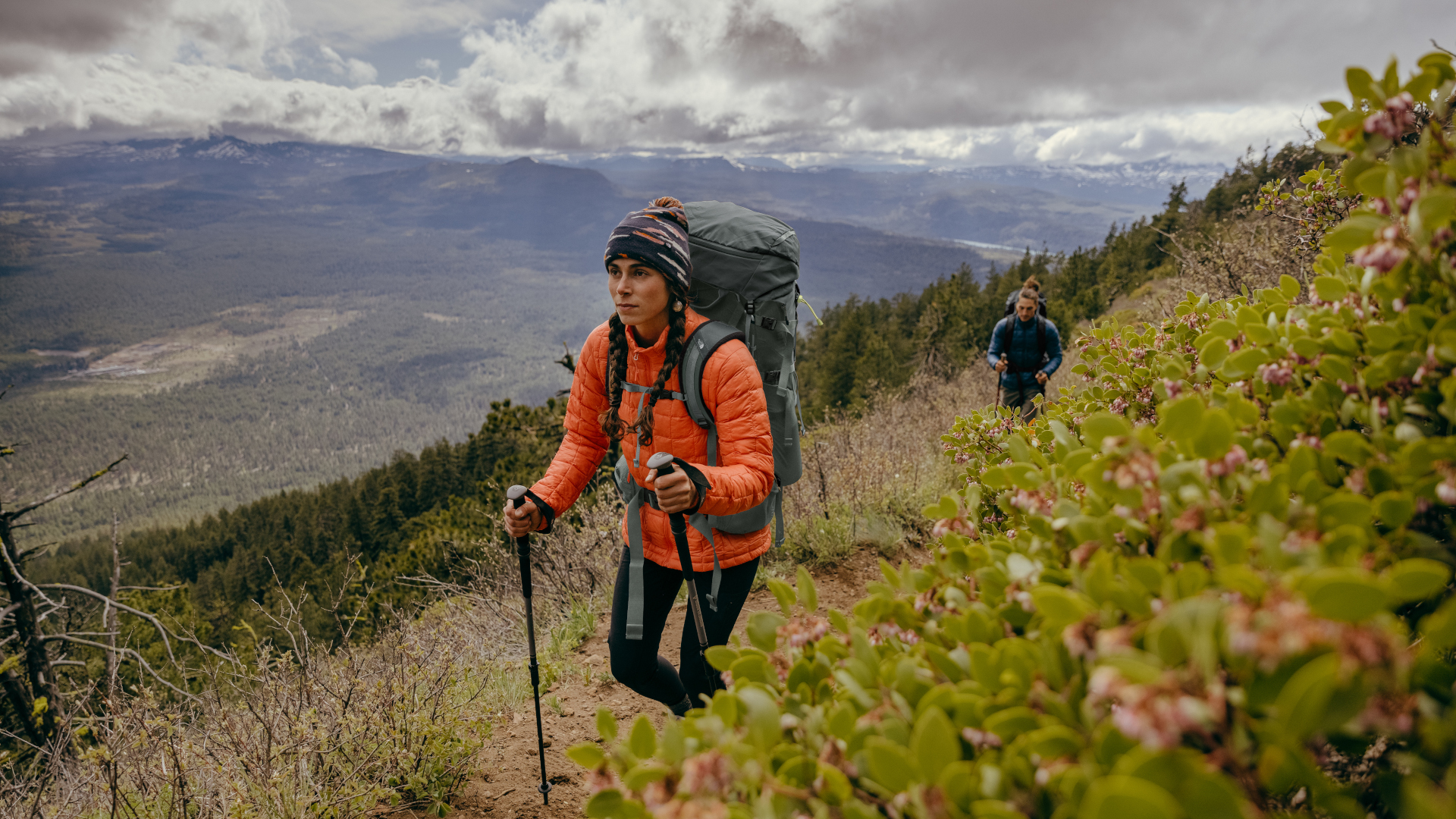Advnture Verdict
This lightweight but high performing down jacket is made from recycled fabric and should be essential kit for any cold weather hiker, keeping you warm even when wet as a trusted mid or outer layer
Pros
- +
Lightweight and compressible
- +
Water repellent and wind resistant
- +
100% recycled materials
- +
Synthetic down provides insulation, even when wet
- +
Flattering athletic cut
- +
Deep zipped hand pockets
Cons
- -
No stuff sack pocket like previous models
- -
Shiny fabric of women’s models isn’t for everyone
You can trust Advnture
The North Face Thermoball Eco Jacket: first impressions
On the rack, this latest generation of The North Face’s popular synthetic down jacket is substantially lighter weight than previous models while retaining hefty insulation. Made from 100% recycled materials, it’s really the perfect way to protect yourself from the cold and our landfills from more plastic bottles.
Thermoball is an insulation technology that uses the small round Primaloft synthetic fiber clusters to mimic down clusters, trapping heat within small air pockets to retain warmth. The result is a toasty outer layer on cold days, and an effective mid layer once the temperatures really drop or in very wet conditions. Water repellency means it will keep you dry against a light shower, while synthetic insulation means it keeps you warm even when you get wet.
Featuring a slim, athletic cut, this jacket has traded in the bulkiness of lots of pockets and straps and placed all its chips on a sleek, minimalist design with two deep, zipped hand pockets and one interior zipped chest pocket. The lack of bulk makes it great for moving on the mountain but leaves enough room for layering, and this jacket is really essential kit for hiking in cold weather, and even skiing in dry conditions.
As an added bonus, it comes in both hooded and high neck versions.
• RRP: $199 / £160
• Sizes available: Men’s S - XL, Women’s XS - XXXL
• Materials: 100% recycled Nylon shell and Polyester fill
• Weight: 518g / 18 oz
• Colors: White, Blackberry wine, Monterrey blue, Arrowwood yellow, Silver blue, Meld grey, Shaded spruce, Emberglow orange, Black
• Best use: hiking, camping, winter sports
The North Face Thermoball Eco Jacket: on the trails

Ten years ago my North Face down jacket was stolen from a yoga studio in Boulder and I still think about it all the time. Today, I feel like I can finally let it go with the arrival of The North Face Thermoball Eco Jacket, which I like so much that my boyfriend and I have broken our cardinal rule of not being that outdoorsy couple that wears matching jackets.
Kidding aside, this jacket has quickly secured its spot in my cold weather kit owing to its ultra light weight, exceptional warmth and trim fit, while its planet-friendly manufacturing totally seals the deal for me. This is the newest generation of the Thermoball line and the jackets just keep getting lighter and more sustainable. It’s now made from 100% recycled materials which is massively important for me.
This quilted jacket has a nice, trim fit and is not at all bulky and very easy to move in for hiking and skiing. They’ve gone for a minimalist look, with two deep zipped hand pockets that are great when you don’t have gloves and one hidden chest pocket, and this keeps it sleek and very packable. Though previous versions have come with a pocket you can pack it into, you can still easily squash this down in your pack.
All of this said, it also offers plenty of warmth on cold days. I have worn this on a couple of cold days with just a light base layer underneath and have been nice and warm while hiking. It would definitely suffice for not-too-cold ski days too, and it’s light enough that it can easily make a mid layer under your hardshell or rain jacket. They’ve updated the design and seams so there are no chilly drafts on a windy day anywhere that I can feel.
I got caught in a light shower in it a few days ago and the water repellency definitely works against that kind of rain, though of course it won’t protect you against prolonged, heavy rain. Because it’s synthetic down, it also keeps you warm even when it gets wet, which is a huge plus now I’m back in Scotland. I also broke a sweat in it on a milder day and didn’t get all clammy, which is huge.
My version boasts a classic high collar cut, but you can also get this in a hooded version. The women’s version (check out our guide to the best women's down jackets) is made using a slightly shiny material, which isn’t for everyone, but that’s a minor quibble for an otherwise excellent jacket good for spring, fall and winter hikes.
Here’s how it performed:
Sizing
True to size, I wear a small and this one leaves me room to move and layer, but doesn’t have too much extra bagginess anywhere.
Fit
Slim fitting and sleek with minimal pockets. I like the high collar that keeps the draft off my neck.
Comfort
Very comfortable because it’s so lightweight and easy to move in. The fabric is nice and smooth and there’s no irritating rub from the zipper even when you pull it all the way up to your chin. I’ve found myself wearing it around town as well as on the trails.
Temperature regulation
Excellent warmth for such a lightweight jacket. This works as an outer and mid layer depending on the conditions, and I loved that I didn’t cool off when I broke a sweat on a colder day, or when I got caught in a shower.
Breathability
Good breathability, especially if you’re wearing it over a base layer. I did break a sweat in it but never felt clammy, which I hate.
Durability
It’s a really well made and designed jacket, so keep it away from thorny bushes on the trail and don’t wash it too often and it should last you a long time.
Here’s where we tested The North Face Thermoball Eco Jacket:
Ben Arthur, otherwise known as The Cobbler, is a distinctive peak at the head of Loch Lomond. The true summit requires some technical scrambling that many choose to miss.
Julia Clarke is a staff writer for Advnture.com and the author of the book Restorative Yoga for Beginners. She loves to explore mountains on foot, bike, skis and belay and then recover on the the yoga mat. Julia graduated with a degree in journalism in 2004 and spent eight years working as a radio presenter in Kansas City, Vermont, Boston and New York City before discovering the joys of the Rocky Mountains. She then detoured west to Colorado and enjoyed 11 years teaching yoga in Vail before returning to her hometown of Glasgow, Scotland in 2020 to focus on family and writing.


